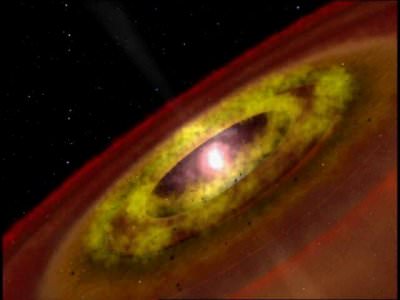[/caption]
Stars like our Sun will spend billions of years in the main sequence stage of their lives, steadily converting hydrogen into helium in their cores, and releasing a tremendous amount of energy. But stars also have a few stages before they settle down as main sequence stars. Let’s take a look at young stars.
All stars begin their lives a vast clouds of cold molecular gas, floating for eons in the galaxy. Suddenly some event, like a nearby supernova explosion, upsets the gravitational balance of the cloud, forcing it to collapse. As the cloud collapses, it breaks off into huge chunks, each of which will continue collapsing on its own to become a star.
After a few thousand years, a large amount of material will have collected together into a huge ball of gas and dust called a protostar. This young star will continue to gather new material for another 100,000 years or so. Material swirls around the protostar, obscuring it from view from Earth-based telescopes. Because of conservation of momentum of all the separate gas atoms, the protostar will spin rapidly, and twin jets will erupt from its poles, releasing energy.
When all of the material has gathered together into the protostar, it becomes a T Tauri star; another kind of young star. The T Tauri star looks like a regular star, except it’s more active and violent. But a T Tauri is actually powered through the heat of its gravitational friction. The star is slowly crushing itself inwards with its gravity, and there’s no force to counteract it. As it crushes down smaller and smaller, its core heats up until it reaches the magic temperature of about 15 million degrees Kelvin. At this point, the young star’s core is hot enough for nuclear fusion.
At this point, it’s no longer a young star, and has graduated to be come a familiar main sequence star.
We have written many articles about stars here on Universe Today. Here’s an article about a young star growing up, and here’s one about a young star blasting out jets of water.
If you’d like more information on stars, check out Hubblesite’s News Releases about Stars, and here’s the stars and galaxies homepage.
We have recorded several episodes of Astronomy Cast about stars. Here are two that you might find helpful: Episode 12: Where Do Baby Stars Come From, and Episode 13: Where Do Stars Go When they Die?
Reference:
http://abyss.uoregon.edu/~js/ast222/lectures/lec11.html

